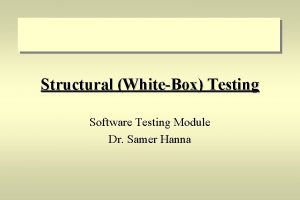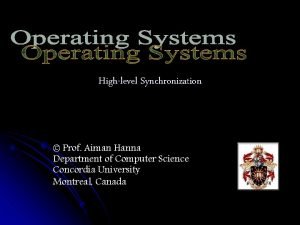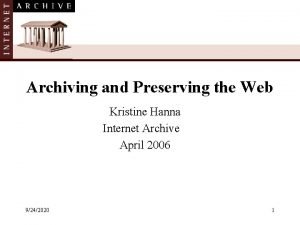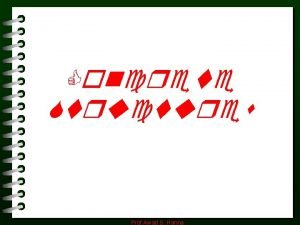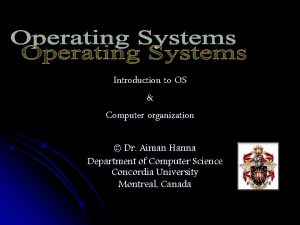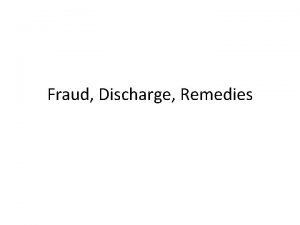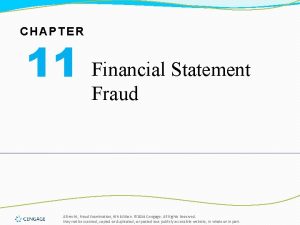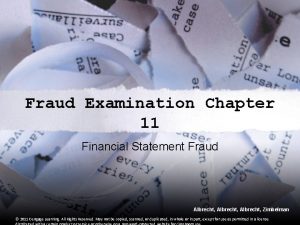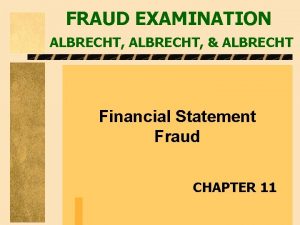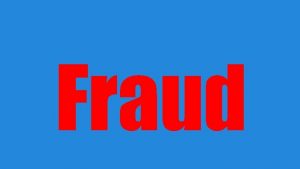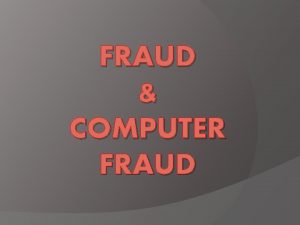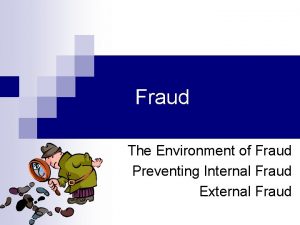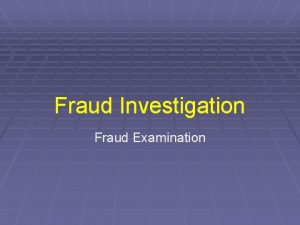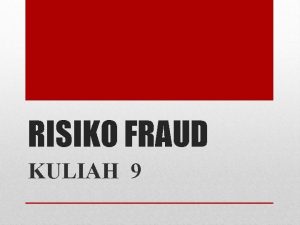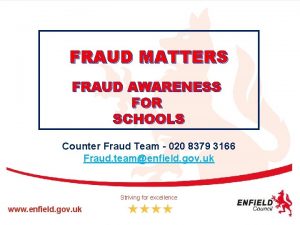Financial Statement Fraud Hanna C Quffa Pop Quiz





















































- Slides: 53

Financial Statement Fraud Hanna C Quffa

Pop Quiz Name at least three of the five principle financial statement fraud schemes.

Financial Statement Fraud Defined ¡ Deliberate misstatements or omissions of amounts or disclosures of financial statements to deceive financial statement users, particularly investors and creditors

Defining Financial Statement Fraud ¡ ¡ Falsification, alteration, or manipulation of material financial records, supporting documents, or business transactions Material intentional omissions or misrepresentations of events, transactions, accounts, or other significant information from which financial statements are prepared Deliberate misapplication of accounting principles, policies, and procedures used to measure, recognize, report, and disclose economic events and business transactions Intentional omissions of disclosures or presentation of inadequate disclosures regarding accounting principles and policies and related financial amounts

Costs of Financial Statement Fraud ¡ ¡ More than 50% of U. S. corporations are victims of fraud with losses of more than $500, 000 (Albrecht & Searcy 2001) Enron lost about $70 billion in market capitalization to investors, employees, and pensioners Enron, World. Com, Quest, Global Crossing, and Tyco’s loss to shareholders was $460 billion (Cotton 2002) Other fraud costs are legal costs, increased insurance costs, loss of productivity, adverse impacts on employee morale, customers’ goodwill, suppliers’ trust, and negative stock market reactions

Frequency of Types of Occupational Fraud and Abuse

Median Loss of Types of Occupational Fraud and Abuse

Effects of Financial Statement Fraud ¡ ¡ Undermines the reliability, quality, transparency, and integrity of the financial reporting process Jeopardizes the integrity and objectivity of the auditing profession, especially auditors and auditing firms Diminishes the confidence of the capital markets, as well as market participants, in the reliability of financial information Makes the capital markets less efficient

Effects of Financial Statement Fraud ¡ ¡ Adversely affects the nation’s economic growth and prosperity Results in huge litigation costs Destroys careers of individuals involved in financial statement fraud. Causes bankruptcy or substantial economic losses by the company engaged in financial statement fraud

Effects of Financial Statement Fraud ¡ ¡ Encourages regulatory intervention Causes devastation in the normal operations and performance of alleged companies Raises serious doubt about the efficacy of financial statement audits Erodes public confidence and trust in the accounting and auditing profession

Who Commits Financial Statement Fraud ¡ Senior management ¡ Mid and lower level employees ¡ Organized criminals

Why Do People Commit Financial Statement Fraud ¡ To conceal true business performance ¡ To preserve personal status/control ¡ To maintain personal income/wealth

Why Senior Management Will Overstate Business Performance ¡ ¡ ¡ To meet or exceed the earnings or revenue growth expectations of stock market analysts To comply with loan covenants To increase the amount of financing available from asset based loans To meet a lender’s criteria for granting/extending loan facilities To meet corporate performance criteria set by the parent company

Why Senior Management Will Overstate Business Performance ¡ ¡ To meet personal performance criteria To trigger performance related compensation or earn out payments To support the stock price in anticipation of a merger, acquisition, or sale of personal stockholding To show a pattern of growth to support a planned securities offering or sale of the business

Why Senior Management Will Understate Business Performance ¡ ¡ ¡ To defer “surplus” earnings to the next accounting period. To take all possible write offs in one “big bath” now so future earnings will be consistently higher. To reduce expectations now so future growth will be better perceived and rewarded. To preserve a trend of consistent growth, avoiding volatile results. To reduce the value of an owner managed business for purposes of a divorce settlement. To reduce the value of a corporate unit whose management is planning a buyout

How Do People Commit Financial Statement Fraud ¡ Playing the accounting system ¡ Beating the accounting system ¡ Going outside the accounting system

Conceptual Framework for Financial Reporting ¡ Recognition and measurement concepts l Assumptions ¡ Economic ¡ Going entity concern ¡ Monetary unit ¡ Periodicity

Recognition and Measurement Concepts ¡ Principles Historical cost l Revenue recognition l Matching l Full disclosure l

Recognition and Measurement Concepts ¡ Constraints l Cost-benefit l Materiality l Industry practice l Conservatism

Qualitative Characteristics ¡ Relevance and reliability ¡ Comparability and consistency

Responsibility for Financial Statements Company management is responsible for financial statements ¡ Company’s board of directors and senior management set the code of conduct ¡ Company’s “ethic” – the standard by which all other employees will tend to conduct themselves ¡

Users of Financial Statements Transaction Activity Accounting System Bankers Investors Vendors Government Management Information Users Decisions Loan Approval Financial Investment Credit Approval Operational & Financial Decisions Financial Statements Balance Sheet Income Statement of Owner Equity Statement of Cash Flows

Financial Statements Balance sheet ¡ Statement of income or statement of operations ¡ Statement of retained earnings ¡ Statement of cash flows ¡ Statement of changes in owner’s equity ¡ Notes ¡

Financial Statements Other Basis ¡ Other comprehensive bases of accounting, l l Government or regulatory agency accounting Tax basis accounting Cash receipts and disbursements, or modified cash receipts and disbursements Any other basis with a definite set of criteria applied to all material items, such as the price level basis of accounting

Other Financial Data Presentations ¡ ¡ ¡ ¡ Prospective financial information Pro forma financial statements Proxy statements Interim financial information Current value financial representations Personal financial statements Bankruptcy financial statements Registration statement disclosures

Methods of Financial Statement Fraud ¡ Fictitious revenues ¡ Timing differences ¡ Improper asset valuations ¡ Concealed liabilities and expenses ¡ Improper disclosures

Financial Statement Schemes by Category

Fictitious Revenues ¡ Recording of goods or services that did not occur ¡ Fake or phantom customers ¡ Legitimate customers ¡ Sales with conditions ¡ Pressures to boost revenues

Red Flags – Fictitious Revenues ¡ ¡ ¡ Rapid growth or unusual profitability, especially compared to that of other companies in the same industry Recurring negative cash flows from operations or an inability to generate cash flows from operations while reporting earnings and earnings growth Significant transactions with related parties or special purpose entities not in the ordinary course of business or where those entities are not audited or are audited by another firm

Red Flags – Fictitious Revenues ¡ ¡ Significant, unusual, or highly complex transactions, especially those close to period end that pose difficult “substance over form” questions Unusual growth in the number of days’ sales in receivables A significant volume of sales to entities whose substance and ownership is not known An unusual surge in sales by a minority of units within a company, or of sales recorded by corporate headquarters

Timing Differences ¡ Recording revenue and/or expenses in improper periods ¡ Shifts revenues or expenses between one period and the next, increasing or decreasing earnings as desired

Red Flags – Timing Differences ¡ ¡ ¡ Rapid growth or unusual profitability, especially compared to that of other companies in the same industry Recurring negative cash flows from operations or an inability to generate cash flows from operations while reporting earnings and earnings growth Significant, unusual, or highly complex transactions, especially those close to period end that pose difficult “substance over form” questions Unusual increase in gross margin or margin in excess of industry peers Unusual growth in the number of days’ sales in receivables Unusual decline in the number of days’ purchases in accounts payable

Concealed Liabilities ¡ Liability/expense omissions ¡ Capitalized expenses ¡ Failure to disclose warranty costs and liabilities

Red Flags – Concealed Liabilities ¡ ¡ ¡ Recurring negative cash flows from operations or an inability to generate cash flows from operations while reporting earnings and earnings growth Assets, liabilities, revenues, or expenses based on significant estimates that involve subjective judgments or uncertainties that are difficult to corroborate Non financial management’s excessive participation in or preoccupation with the selection of accounting principles or the determination of significant estimates

Improper Disclosures ¡ Liability omissions ¡ Subsequent events ¡ Management fraud ¡ Related party transactions ¡ Accounting changes

Red Flags – Improper Disclosures ¡ ¡ Domination of management by a single person or small group (in a non owner managed business) without compensating controls Ineffective board of directors or audit committee oversight over the financial reporting process and internal control Ineffective communication, implementation, support, or enforcement of the entity’s values or ethical standards by management or the communication of inappropriate values or ethical standards Rapid growth or unusual profitability, especially compared to that of other companies in the same industry

Red Flags – Improper Disclosures ¡ ¡ Significant, unusual, or highly complex transactions, especially those close to period end that pose difficult “substance over form” questions Significant related party transactions not in the ordinary course of business or with related entities not audited or audited by another firm Significant bank accounts or subsidiary or branch operations in tax haven jurisdictions for which there appears to be no clear business justification Overly complex organizational structure involving unusual legal entities or managerial lines of authority

Red Flags – Improper Disclosures ¡ ¡ ¡ Known history of violations of securities laws or other laws and regulations, or claims against the entity, its senior management, or board members alleging fraud or violations of laws and regulations Recurring attempts by management to justify marginal or inappropriate accounting on the basis of materiality Formal or informal restrictions on the auditor that inappropriately limit access to people or information or the ability to communicate effectively with the board of directors or audit committee

Red Flags – Concealed Liabilities ¡ ¡ Unusual increase in gross margin or margin in excess of industry peers Allowances for sales returns, warranty claims, and so on that are shrinking in percentage terms or are otherwise out of line with industry peers Unusual reduction in the number of days’ purchases in accounts payable Reducing accounts payable while competitors are stretching out payments to vendors

Improper Asset Valuation ¡ Inventory valuation ¡ Accounts receivable ¡ Business combinations ¡ Fixed assets

Red Flags – Improper Asset Valuation ¡ ¡ ¡ Recurring negative cash flows from operations or an inability to generate cash flows from operations while reporting earnings and earnings growth Significant declines in customer demand increasing business failures in either the industry or overall economy Assets, liabilities, revenues, or expenses based on significant estimates that involve subjective judgments or uncertainties that are difficult to corroborate Non financial management’s excessive participation in or preoccupation with the selection of accounting principles or the determination of significant estimates Unusual increase in gross margin or margin in excess of industry peers

Red Flags – Improper Asset Valuation ¡ ¡ ¡ Unusual growth in the number of days’ sales in receivables Unusual growth in the number of days’ purchases in inventory Allowances for bad debts, excess and obsolete inventory, and so on that are shrinking in percentage terms or are otherwise out of line with industry peers Unusual change in the relationship between fixed assets and depreciation Adding to assets while competitors are reducing capital tied up in assets

Detection of Fraudulent Financial Statement Schemes SAS 99 – Consideration of Fraud in a Financial Statement Audit as well as ISA ¡ “The auditor has a responsibility to plan and perform the audit to obtain reasonable assurance about whether the financial statements are free of material misstatement, whether caused by error or fraud. ” ¡

Auditing Standards ¡ Description and characteristics of fraud l l ¡ ¡ Misstatements arising from fraudulent financial reporting Misstatements arising from misappropriation of assets Importance of exercising professional skepticism Discussion among engagement personnel regarding risk of material misstatement due to fraud l l Brainstorming Internal and external pressures

Auditing Standards ¡ Obtaining information needed to identify risks of material misstatement due to fraud l l Making inquiries of management about the risks of fraud and how they are addressed Consider any unusual or unexpected relationships that have been identified in performing analytical procedures in planning the audit. Consider whether one or more fraud risk factors exist. Consider other information that may be helpful in the identification of risks of material misstatement due to fraud

Auditing Standards – Audit Documentation ¡ ¡ Contains a list of factors that the auditor should consider in determining the nature and extent of the documentation for a particular audit area Contains a new requirement for auditors to document audit findings or issues that in their judgment are significant, actions taken to address them Retains much of the ownership/record retention guidance Contains amendments adding specific documentation requirements to other ISA

Financial Statement Analysis ¡ Vertical analysis l ¡ Horizontal analysis l ¡ Analyzes the relationships between the items on an income statement, balance sheet, or statement of cash flows by expressing components as percentages Analyzes the percentage change in individual financial statement items Ratio analysis l Measures the relationship between two different financial statement amounts

Deterrence of Financial Statement Fraud ¡ Reduce pressures to commit financial statement fraud ¡ Reduce the opportunity to commit financial statement fraud ¡ Reduce rationalization of financial statement fraud

Reduce Pressures to Commit Financial Statement Fraud ¡ ¡ ¡ ¡ Establish effective board oversight of the “tone at the top” created by management. Avoid setting unachievable financial goals. Avoid applying excessive pressure on employees to achieve goals. Change goals if changed market conditions require it Ensure compensation systems are fair and do not create too much incentive to commit fraud. Discourage excessive external expectations of future corporate performance. Remove operational obstacles blocking effective performance.

Reduce the Opportunity to Commit Financial Statement Fraud ¡ ¡ ¡ Maintain accurate and complete internal accounting records. Carefully monitor the business transactions and interpersonal relationships of suppliers, buyers, purchasing agents, sales representatives, and others who interface in the transactions between financial units. Establish a physical security system to secure company assets, including finished goods, cash, capital equipment, tools, and other valuable items. Maintain accurate personnel records including background checks on new employees. Encourage strong supervisory and leadership relationships within groups to ensure enforcement of accounting procedures. Establish clear and uniform accounting procedures with no exception clauses.

Reduce Rationalization of Financial Statement Fraud ¡ ¡ ¡ Promote strong values, based on integrity, throughout the organization. Have policies that clearly define prohibited behavior with respect to accounting and financial statement fraud. Provide regular training to all employees communicating prohibited behavior.

Reduce Rationalization of Financial Statement Fraud ¡ ¡ Have confidential advice and reporting mechanisms to communicate inappropriate behavior. Have senior executives communicate to employees that integrity takes priority and that goals must never be achieved through fraud. Ensure management practices what it preaches and sets an example by promoting honesty in the accounting area. The consequences of violating the rules and the punishment of violators should be clearly communicated

Thank You
 How do fraud symptoms help in detecting fraud
How do fraud symptoms help in detecting fraud 5.11 quiz fraud
5.11 quiz fraud What does pop art stand for
What does pop art stand for World of 7 billion pop quiz answers
World of 7 billion pop quiz answers Holes chapter 1-5 quiz
Holes chapter 1-5 quiz Cuprimdso
Cuprimdso Poetic pop quiz
Poetic pop quiz Poetic pop quiz
Poetic pop quiz Brainpop pop art quiz answers
Brainpop pop art quiz answers Pop quiz definition
Pop quiz definition Maths pop quiz
Maths pop quiz Pop quiz games
Pop quiz games Swot analysis of davao region
Swot analysis of davao region Jennifer hanna md
Jennifer hanna md Hanna sikora
Hanna sikora Dd path testing
Dd path testing Hanna nyfors
Hanna nyfors Orleans hanna algebra prognosis test
Orleans hanna algebra prognosis test Hanna simple
Hanna simple Jolanta jurkowska
Jolanta jurkowska Hanna drac
Hanna drac Aiman hanna concordia
Aiman hanna concordia Hanna stakheyeva
Hanna stakheyeva Hanna raatikainen
Hanna raatikainen Valosähköilmiö
Valosähköilmiö Hanna rothkaehl
Hanna rothkaehl Tomas hanna coatesville
Tomas hanna coatesville Boxeadora costarricense
Boxeadora costarricense Kristine hanna
Kristine hanna Hanna keskinen
Hanna keskinen Hanna hartleb
Hanna hartleb Hanna hyttinen
Hanna hyttinen Serge hanna
Serge hanna Since hanna moved away
Since hanna moved away Hannah herman cortes
Hannah herman cortes Emosjonsveiledning
Emosjonsveiledning Elias hanna cardiology
Elias hanna cardiology Hanna kryszewska
Hanna kryszewska Jenni kuvaja
Jenni kuvaja Serge hanna
Serge hanna Hanna happo
Hanna happo Mercurys composition
Mercurys composition Serge hanna
Serge hanna Hanna arentd
Hanna arentd Hanna hakko
Hanna hakko Hanna f. pitkin
Hanna f. pitkin Hanna concrete
Hanna concrete Tiina strengell kokemuksia
Tiina strengell kokemuksia Hanna torp
Hanna torp Naarajärven vankila
Naarajärven vankila Przyszła jesień do gosposi
Przyszła jesień do gosposi Aiman hanna
Aiman hanna Integracion vertical hacia atras
Integracion vertical hacia atras Serge hanna
Serge hanna















